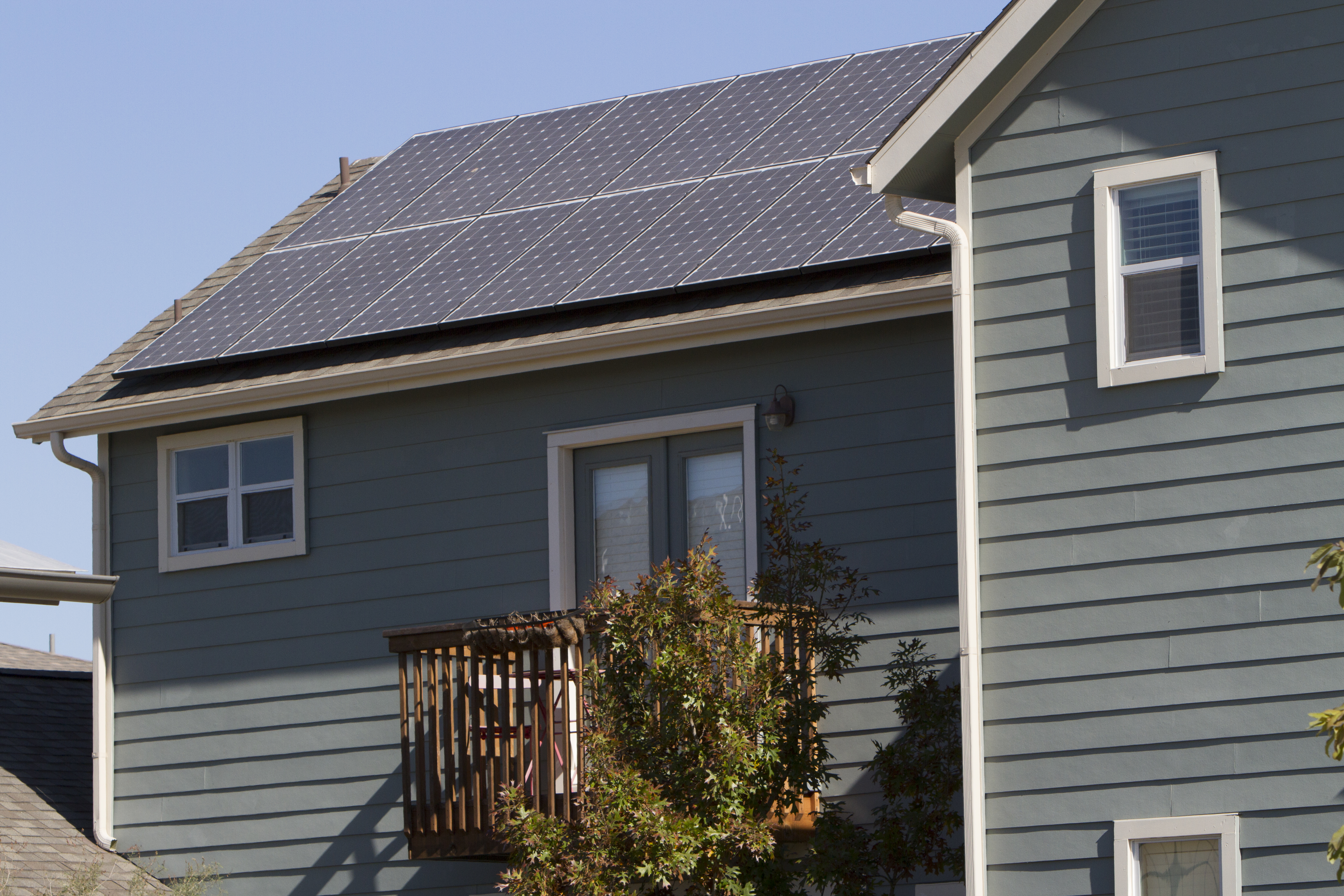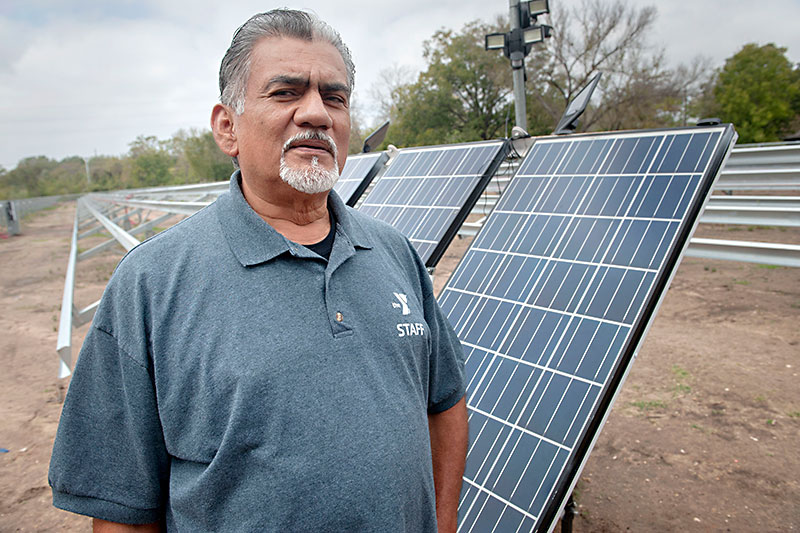By Drew O'Bryan, Clean Energy Coordinator

For years, visions of a clean energy future were hampered by the premium price that renewable power commanded. It’s unsurprising that the benefits of these resources have disproportionately fallen to wealthier households that can foot the bill for solar panels on their rooftop or pay a bit extra each month for a renewable power program through their local utility. But as wind energy has become cost competitive with natural gas and helped to shove many old, dirty coal plants off the Texas energy market (wind turbines have produced more than 15% of all Texas electricity in 2017), solar power is beginning its moment in the sun too.
Two Central Texas utilities, Pedernales Energy Cooperative (PEC) and Austin Energy, unveiled plans this year to use locally-generated solar power to save electricity customers money on their monthly bills.
Applications opened on Dec. 4 for PEC customers to subscribe to a share of the power produced on a first-come-first-served basis, and households will begin seeing solar on their bills starting in February 2018.
When you think of solar power, you might imagine a shiny set of solar panels resting atop an eco-conscious home. But for many Texans, it’s tougher to envision those same panels set on their own rooftop. For those who own their home, solar panels might require an upfront cost or line of credit for installation that, even with incentives and loans, can still be inaccessible for lower-income families (it should be noted that there are alternative business models that do not require a large upfront cost to put solar on residential rooftops). Even those who can afford to go solar or find a company willing to lease their panels with no down payment might be thwarted by shade-trees or an old roof, and renters may lack the option entirely. So how do PEC and Austin Energy plan on saving customers money with this same technology so that everyone has the opportunity to contribute to a clean energy future?
The answer is community solar, which keeps solar local and allows residents to subscribe to a share of a mid-sized solar farm.
This past spring, Pedernales Electric Cooperative announced its plan to build 15 community solar farms dotted throughout its service territory. The 15 projects are each rated for one megawatt (MW) of energy, meaning that total power produced will be able to power 3,000 average homes. PEC is also planning to add battery technology to at least some of these projects as part of a grant they received recently through the Texas Emissions Reduction Plan (aka, TERP).
But signing up for PEC’s community solar program won’t just help us transition from fossil fuels and save the planet. Customers can sign up to provide up to 100% of their average monthly electricity use with solar power at a rate cheaper than the standard electric price offered by the co-op. While PEC members currently pay 6.1 cents for each kilowatt-hour (kWh) of energy, solar energy will be offered at a rate of 5.6 cents per kWh. While the savings aren’t extraordinary – they’ll save the average household about $5 per month over the initial 24-month contract – they do point towards a new trend: Solar power costs have plummeted in recent years and developments in solar technology will continue to push prices even lower in the years to come.
“We felt that a community and a utility could work together to deliver more options for cost-effective, sustainable power,” Ingmar Sterzing, PEC Vice President of Power Supply and Energy Services, said when the projects were announced earlier this year.
Employing a similar strategy of using solar power to benefit the community where it’s located, Austin Energy recently announced its own plan for a community solar project in East Austin, named La Loma project, where electricity produced will be reserved and discounted for low-income households. The 1.25 MW solar farm will be able to power about 200 homes with 50% reserved for eligible low-income customers under a current Austin Energy proposal, which still must be approved by City Council. (A public hearing has been set for Thursday, December 14, 2017, beginning at 4:00pm at Austin City Hall, 301 W. Second Street).

Peter Rivera, former executive committee member of Sierra Club's Austin group and current Springdale-Airport Neighborhood Association president, at La Loma Community Solar Farm (Photo Credit: John Anderson for Austin Chronicle)
The decision to reserve part of the solar farm for low-income customers was a specific demand of many within the community, including the Sierra Club, which will be supporting the proposed tariff. In addition, the solar farm is being combined with a 1.25 MW battery storage facility, supported both by federal and state funding as part of the SHINES project.
The standard community solar rate will be at a slight premium above the regular rate and will cost an average of an extra $10-16 each month, but those customers who subscribe to a share of the solar farm will have that rate locked in for 15 years with no cancellation fee – a benefit in itself to hedge against any future rate increases. However, for low-income participants, the community solar rate will be two-thirds the price of the rate for higher-earners, coming in at a slight discount over the non-solar energy rate with the same 15-year fixed terms.
“We’ve heard time and time again from many working class people of East Austin, Dove Springs, and Colony Park that they want clean energy, but not if it means at an additional cost to bills they can barely keep up with,” said Dave Cortez, organizer with the Sierra Club. “This, along with other moves to expand access to home weatherization, demonstrate that the Austin Energy team is willing to listen to and act in response to community demands for equitable clean energy.”
Both PEC and Austin Energy’s programs signal a departure from standard operations for electric utilities. In contrast to energy sources like coal and nuclear, solar power can scale from small home installations to massive utility-scale farms in West Texas hundreds of times larger than PEC’s community projects. In a clean energy future, each size, along with wind power and energy storage, holds its own important purpose. Community solar programs keep electricity local and can be used to directly benefit the communities where they are located.
For fossil fuels like coal and natural gas, their power plants come with devastating environmental impacts to the land, water, and air where they operate. A clean energy future must be equitable, and Central Texas can be a model for how the state and nation as a whole can transition to 100% renewable energy in a way that benefits all who call it home.